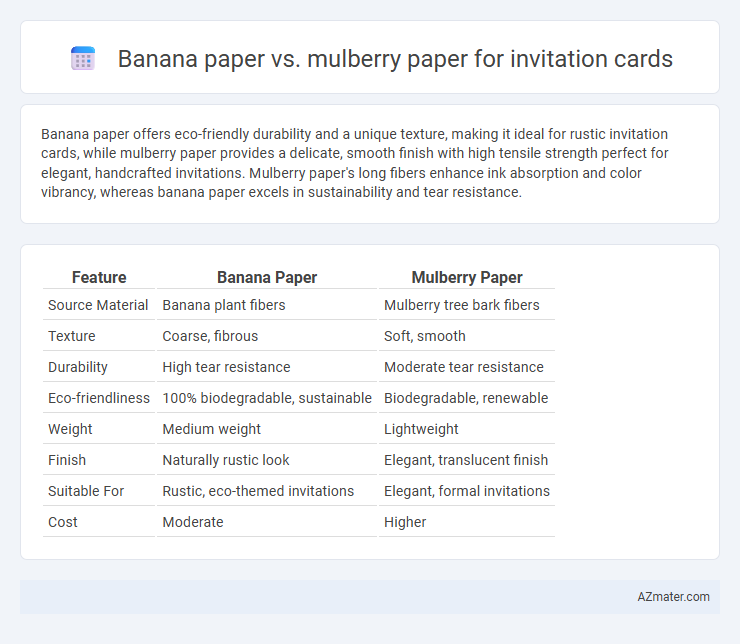Banana paper offers eco-friendly durability and a unique texture, making it ideal for rustic invitation cards, while mulberry paper provides a delicate, smooth finish with high tensile strength perfect for elegant, handcrafted invitations. Mulberry paper's long fibers enhance ink absorption and color vibrancy, whereas banana paper excels in sustainability and tear resistance.
Table of Comparison
| Feature | Banana Paper | Mulberry Paper |
|---|---|---|
| Source Material | Banana plant fibers | Mulberry tree bark fibers |
| Texture | Coarse, fibrous | Soft, smooth |
| Durability | High tear resistance | Moderate tear resistance |
| Eco-friendliness | 100% biodegradable, sustainable | Biodegradable, renewable |
| Weight | Medium weight | Lightweight |
| Finish | Naturally rustic look | Elegant, translucent finish |
| Suitable For | Rustic, eco-themed invitations | Elegant, formal invitations |
| Cost | Moderate | Higher |
Introduction to Eco-Friendly Invitation Cards
Banana paper and mulberry paper represent sustainable choices for eco-friendly invitation cards, each offering unique textures and environmental benefits. Banana paper is crafted from banana plant fibers, providing durability and a rustic appearance while supporting agricultural waste reduction. Mulberry paper, derived from the inner bark of the Morus alba tree, delivers a soft, fibrous texture with exceptional strength, making both options ideal for biodegradable, renewable invitations.
What is Banana Paper?
Banana paper is an eco-friendly material made from the fibers of banana plants, offering durability and a unique textured finish ideal for invitation cards. Unlike mulberry paper, which is crafted from the fibrous bark of the mulberry tree, banana paper tends to have a coarser feel and natural yellowish hue, providing a rustic and organic aesthetic. Its sustainable production process utilizes agricultural waste, making banana paper a popular choice for environmentally conscious event invitations.
What is Mulberry Paper?
Mulberry paper, made from the inner bark fibers of the Morus alba tree, is renowned for its strength, texture, and durability, making it an excellent choice for elegant invitation cards. It offers a natural, fibrous appearance that adds a unique, handmade aesthetic while being eco-friendly and biodegradable. Compared to banana paper, mulberry paper is typically smoother and more uniform, providing a refined surface ideal for detailed printing or calligraphy on invitations.
Production Process: Banana vs Mulberry Paper
Banana paper is made from the fibers of banana plant stems, utilizing a sustainable process that repurposes agricultural waste and involves soaking, pulping, and drying to create a textured, eco-friendly sheet. Mulberry paper originates from the inner bark of the Mulberry tree, processed through stripping, boiling, and beating fibers to produce a soft, fibrous sheet known for its durability and smooth surface. The banana paper production emphasizes waste reduction and sustainability, while Mulberry paper focuses on traditional craftsmanship and strength.
Texture and Appearance Comparison
Banana paper features a coarse, fibrous texture that imparts a rustic and organic appearance, ideal for eco-friendly invitation cards with a natural vibe. Mulberry paper offers a smoother, more delicate surface with visible long fibers, providing an elegant and artisanal look suited for sophisticated or traditional invitations. The choice between banana and mulberry paper influences the tactile experience and visual appeal, balancing durability with aesthetic refinement.
Durability and Strength Analysis
Banana paper exhibits superior tensile strength and tear resistance compared to mulberry paper, making it an ideal choice for durable invitation cards that withstand handling and mailing. The fiber composition in banana paper creates a dense, sturdy texture, while mulberry paper, though lightweight and flexible, offers less resilience under stress. For long-lasting invitations, banana paper provides enhanced durability without sacrificing aesthetic appeal.
Eco-Impact and Sustainability
Banana paper, made from agricultural waste fibers, offers a highly sustainable alternative by repurposing banana plant byproducts and reducing deforestation. Mulberry paper, derived from the bark of the Morus alba tree, is also eco-friendly due to its renewable source and minimal processing requirements, promoting low environmental impact. Both papers support sustainable invitation card production, but banana paper's use of waste material often results in a smaller carbon footprint and less resource consumption.
Printing and Customization Options
Banana paper offers excellent print clarity and vibrant color reproduction, making it ideal for detailed invitation designs, while mulberry paper provides a unique texture that enhances traditional and artistic printing techniques. Customization on banana paper supports various finishes like matte, gloss, and embossing, whereas mulberry paper excels with hand-rolled edges and natural fiber inclusions for a handcrafted look. Both papers accommodate digital and screen printing methods, but banana paper's smooth surface ensures sharper text and intricate patterns.
Cost Considerations for Invitation Cards
Banana paper offers a cost-effective alternative to mulberry paper for invitation cards due to its lower production expenses and abundant raw material availability, making it suitable for bulk orders. Mulberry paper, derived from the bark of mulberry trees, tends to be more expensive because of labor-intensive processing and limited supply, which may increase overall invitation card costs. Choosing banana paper can reduce budget constraints while maintaining eco-friendly qualities, whereas mulberry paper is often selected for its premium texture despite higher costs.
Which Paper Suits Your Event Best?
Banana paper offers a rustic, eco-friendly texture ideal for casual or nature-themed invitations, providing durability and a unique tactile experience. Mulberry paper features a delicate, fibrous composition perfect for elegant, traditional events, enhancing luxury with its soft translucency and intricate texture. Choose banana paper for sustainability and a bold earth-toned aesthetic, while mulberry paper suits formal occasions requiring refined sophistication.

Infographic: Banana paper vs Mulberry paper for Invitation card
 azmater.com
azmater.com